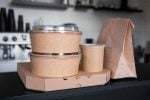Plastic is choking our planet. You know this. I know this. But here’s what you might not realize: the solution isn’t just about minimal packaging and ditching plastic. It’s about reimagining packaging entirely.
Sustainable brands aren’t just talking about eco-friendly product packaging. They’re revolutionizing it. They’re creating boxes that dissolve in your sink, wrappers you can plant in your garden, and containers that might outlast your product – but in all the right ways.
But let’s be honest. Making the switch to truly sustainable packaging isn’t easy. It’s a minefield of greenwashing, confusing terms, and potential missteps that could cost your company and brand dearly.
That’s why we’re here. We’ve done the legwork, separating the true innovators from the pretenders. We’ve uncovered packaging solutions so clever, and so effective, that you’ll wonder why on earth everyone isn’t using them yet.
This isn’t just about feeling good. It’s about future-proofing your business. Because make no mistake – consumers are watching. They’re judging. And they’re ready to reward brands that get this right.
Metrobi drivers are rated 4.97/5
Trusted by local businesses for:
- Background-checked professionals
- Specialized in business deliveries
- Same drivers for consistency
- 4.97/5 average delivery rating
Top Sustainable Packaging Innovations for 2025
Most environmentally friendly packaging options will cut down waste.
Eco-friendly product packaging is often compostable or plant-based, minimizing harm to the environment.
Minimalistic designs not only look good but also reduce material use significantly.
Compostable Packaging
Compostable packaging breaks down into natural elements in a compost environment, returning to the soil safely. Certified by organizations like the Biodegradable Products Institute and the Compost Manufacturing Alliance, it ensures environmentally responsible disposal. Benefits include reducing landfill waste and minimizing environmental impact, offering a viable alternative to traditional plastic packaging that takes centuries to decompose. These qualities make compostable solutions the top choice for eco-conscious companies aiming to improve their sustainability U.S. Plastics Pact Sustainable Packaging Innovation Awards.
Typical compostable materials include PLA (polylactic acid), derived from fermented plant starch like corn. Others are bags made from cornstarch or sugarcane that mimic the durability of plastic bags, without the environmental drawback. There is also mushroom-based packaging, which uses mycelium. Companies like LifeMade Product’s Bioffex are setting new standards by winning recognition for their compostable innovations, proving the viability of these materials in commercial applications.
Adopting compostable packaging involves evaluating existing packaging designs and identifying where compostable materials can be integrated. You can start by conducting a cost-benefit analysis to determine feasibility. Partnering with certified suppliers and engaging in pilot projects can streamline this transition.
Plant-Based Packaging
Plant-based packaging uses materials sourced from renewable biological resources instead of petroleum. Common raw materials used include banana leaves and cornstarch, which are processed into packaging robust enough for various uses from empty boxes to food coverings to shipping materials. This type aligns well with brands focused on reducing their carbon footprint and appealing to environmentally conscious consumers.
Banana leaves offer a biodegradable option traditionally used for natural wrapping in various cultures. Cornstarch packaging, made by processing corn, is another option finding popularity for being lightweight and versatile. Mycelium-based packaging is gaining traction for its robustness and biodegradability. Companies like Ecovative Design leverage mycelium to craft products that replace synthetic foams and plastics effectively.
Engage with experienced suppliers who specialize in sustainable materials to ensure authenticity and quality. Consider certifications that validate the eco-friendliness of products. Networking in industry-specific forums or groups can provide leads on reputable suppliers.
Minimalistic Packaging Designs
Using minimalistic designs means reducing the quantity of material used, leading to a direct drop in production costs and waste. This approach not only conserves resources but also simplifies the reuse and recycling process. For example, businesses are cutting packaging material by up to 30% when adopting these designs, significantly cutting down on waste production. On the other hand, biodegradable packaging is also another great option.
You can start by analyzing current packaging to pinpoint areas of excess. Packaging engineers can redesign components to maintain functionality with less material. Incorporating digital tools and software for simulated testing can be beneficial. Additionally, looking into resources like the Sustainable Packaging Coalition’s guidelines might offer additional strategies on material efficiency relative to design goals.
Biodegradable Packaging Materials: An Up-to-Date Guide
Biodegradable materials are a focus for reducing packaging waste.
Learn about different material types and transition steps.
Get inspired by brands leading the charge in sustainability.
Types of Biodegradable Materials Available
Biodegradable packaging materials are designed to break down naturally and reduce environmental impact. Common options include:
Cellulose: This material, derived from plants, decomposes rapidly. Uncoated cellulose film can decompose in 28 to 60 days, while coated versions take longer (80 to 120 days).
Bioplastics: Derived from sources like corn starch or sugarcane, bioplastics are used for bags and films. These materials are versatile and can replace many forms of traditional plastics.
Paper and Cardboard: Widely used for their high recyclability, with a 68% recycling rate in the US. Recycling paper saves resources such as trees and oil, making it a compelling option for eco-friendly brands.
Pros and Cons of Each Type:
Each biodegradable material comes with its own set of benefits and drawbacks.
Cellulose: Pros include quick decomposition and plant-based origin. Cons involve potential higher costs and limited use compared to traditional plastics.
Bioplastics: Pros are versatility and reduction in petroleum use. Cons include needing specific environmental conditions for decomposition, which can be an adjustment for waste management systems.
Paper and Cardboard: Pros highlight high recyclability and resource savings. The downside is their durability under certain conditions, such as moisture, which is often less than plastic.
Cost Considerations
Biodegradable packaging can initially seem costlier than traditional materials. However, long-term savings from reduced waste penalties and improved environment and brand perception may balance the expenses.
Steps to Transition to Biodegradable Materials
You can start by evaluating your current eco-friendly product packaging options. Identify non-eco-friendly components and explore biodegradable alternatives. A thorough audit can reveal areas for significant improvements.
Choosing the right biodegradable material depends on factors such as your product type, shelf life, and budget. Engage with suppliers to compare options like bioplastics or cellulose. You may also need to collaborate on custom solutions tailored to your products’ needs.
It is best to work closely with suppliers to test biodegradable solutions. This includes monitoring for durability, fit for purpose, and consumer acceptance. Testing can minimize risks, ensuring the selected raw materials meet performance and environmental standards.
Success Stories from Leading Brands
Examples of Brands Using Biodegradable Materials:
Several leading brands have excelled by adopting green, biodegradable packaging:
IKEA: The company’s transition to biodegradable mushroom-based packaging highlights its commitment to sustainability.
Nestlé: Known for using paper-based packaging, helping to reduce its environmental footprint significantly.
Outcomes and Consumer Feedback:
These changes resulted in positive consumer feedback focused on increased brand loyalty and customer satisfaction. IKEA reported soaring customer approval for its eco-friendly initiatives.
Lessons Learned for Other Brands:
Adopting biodegradable materials requires commitment, team collaboration, and continuous improvement. Food brands have proven that consumer trust and market position for packaged names can improve significantly with a strategic commitment to sustainability, such as biodegradable packing peanuts in the market.
Taking Advantage of Eco-Conscious Packaging Trends

Adapt to rising demand with custom eco-packaging.
Source and incorporate recycled materials to boost sustainability.
Overcome the challenges of implementing recycled content.
Customizable and Reusable Packaging
Why Customization is trending
Customized packaging is gaining momentum as brands recognize its potential to boost consumer engagement and brand loyalty. Personalization makes products stand out on crowded shelves, and eco-conscious customization aligns well with consumer demand for sustainable options. A study by Packaging Europe found that 92% of consumers prioritize eco-friendly and sustainable packaging options in their purchasing decisions. This trend reflects a shift towards responsible consumption. The flexibility of customization allows businesses to adapt packaging to market needs, such as using designs that communicate a brand’s commitment to reducing environmental impact.
Benefits of Reusability for Consumers
Reusable packaging offers direct benefits to consumers. It not only reduces waste but also provides value by extending the life of the packaging. Consumers appreciate the practicality, seen in the success of brands utilizing refills and packaging returns. A survey from GreenBiz indicates that one in three consumers prefers reusable packaging for everyday purchases. This preference can translate to brand loyalty and have a positive impact on brand perception. For instance, products with reusable packaging create a bond with buyers, encouraging repeat purchases and fostering an eco-friendly brand image.
Incorporation of Recycled Materials
Current Trends in Using Recycled Content
The incorporation of recycled materials has become a key packaging strategy, for packaging sustainability. This involves not only using post-consumer materials but also designing packaging to be easily recyclable. The push for recycled content is reflected in statistics showing a projected $393 billion market growth in sustainable packaging by 2028. Leading brands are integrating materials like recycled paperboard and plastics, contributing to a circular economy and minimizing virgin material use. The trend supports waste reduction, aligning with consumer values for environmental responsibility.
How to Source Recycled Materials
Sourcing recycled materials requires strategic partnerships and knowledge of supply chains. Companies can engage with suppliers specializing in shipping products made in recycled content or explore partnerships with organizations like TerraCycle, which focuses on waste recovery and recycling. Prioritizing suppliers who adhere to certifications and standards ensures material quality and sustainability. While recycled materials might initially incur higher costs due to sourcing challenges, companies often find long-term savings and improved brand perceptions that outweigh these initial expenses.
Challenges and Solutions in Using Recycled Packaging
Implementing recycled packaging can face hurdles such as higher costs, potential supply chain disruptions, and varying material quality. However, these challenges can be addressed with strategic approaches. Developing a robust supply chain strategy with multiple sourcing options reduces the risk of dependency on single suppliers. Ensuring quality control via testing and certifications guarantees that the packaging needs recycled content and meets brand standards. Furthermore, engaging consumers through clear communication about recycling instructions fosters correct disposal practices and aligns sustainability efforts with customer expectations.
Recyclable and Eco-Friendly Product Packaging Solutions and Future Predictions
Learn top design tips for better recyclability.
Discover new technologies changing packaging.
Understand rising consumer beliefs on sustainability.
Best Practices for Recycling-Friendly Design
Recycling-friendly design is a crucial component of eco-friendly product packaging. Designs need to allow for easy separation of materials and straightforward recycling processes. Many companies are now using single-material packages like PET or HDPE because they are widely accepted in recycling programs. Another tip is to avoid using dark-colored plastics or multilayer materials that recyclers often struggle to process. Getting creative with labeling and adhesives is also key—they shouldn’t contaminate the recycling stream.
Design Tips for Enhancing Recyclability
When designing recyclable products, choose simple materials. Think of reducing print decoration and coatings, which can hinder recycling. Use clear instructions on packaging to guide consumers in proper disposal methods. Stick to widely recyclable plastics when metals or glass aren’t viable. The focus is on making it easy for everyone involved in the recycling chain.
Common Pitfalls to Avoid
It is best to avoid complex packaging systems that mix materials. This mix often leads to non-recyclable waste. You can use labels, stickers, and glue that don’t contaminate recycling bins. Think of the label as a part of the package that shouldn’t interfere with recycling. Check that your chosen recycled material aligns with the facilities where it’s processed.
How to Educate Consumers on Recycling
Communication matters. Brands can engage consumers by highlighting recyclable elements on the packaging. Be clear about disposal instructions. Campaigns and social media can amplify how to recycle properly. Educate through newsletters, packaging labels, compostable mailers, and community events. This approach increases the likelihood that your recyclable packaging ends up where it should.
Innovations Shaping the Future of Recyclable Eco-Friendly Product Packaging
The past year saw several breakthroughs in recyclable packaging technology. These changes are expected to revolutionize how businesses package their goods. From advanced sorting technology to new materials, innovations are reshaping the sector.
Overview of Cutting-Edge Technologies
Advanced recycling technologies like chemical recycling have emerged. They make previously non-recyclable plastics reusable. Technologies, including digital watermarking, improve sorting efficacy, ensuring more materials make it through recycling processes Grandview Research.
Bioplastics are also gaining traction. They offer a sustainable alternative and remain recyclable. Biodegradable and compostable, they don’t contribute to landfill growth. Breakthroughs in nanotechnology further aid in reducing plastic waste.
Possible Impacts on the Packaging Industry
These innovations can reduce waste management costs. They promise lower resource input and transform industry norms. The adoption of cutting-edge technologies could save businesses money and bolster their green credentials. As technology improves, recycling efficiency rises, meaning less waste is wasted overall. Companies focusing on recycled materials will see increased consumer trust.
Steps Brands Can Take to Adopt Innovations
Stay informed by attending trade shows or forums on packaging technologies. It is better to collaborate with tech innovators and industry leaders. Employ pilot programs to explore new packaging materials. Implement feedback loops to evaluate customer satisfaction and product effectiveness. You can start small with test batches before rolling out fully to ensure a smooth transition.
Predicting the Shift in Consumer Expectations
Customer attitudes are evolving towards eco-friendly solutions. Focusing on recyclability is now more crucial than ever. Consumers want environmental responsibility in every aspect of their purchase.
Analysis of Current Consumer Attitudes Towards Sustainability
The drive for cleaner and safer environments has reshaped purchasing behavior. 1 in 5 shoppers currently seeks sustainable brands. The enthusiasm is largely driven by younger customers. They favor companies transparent in their sustainability journey and authentic in their practices and offerings.
Predictions for Consumer Behavior in the Coming Year
Expect demand for sustainable packaging to surge. As eco-awareness spreads, companies, especially in Asia-Pacific, will adopt recyclable solutions faster.
Adapting Marketing Strategies to Meet New Expectations
Highlight your own packaging strategy’s eco-benefits in campaigns. You can make sustainability part of your brand’s story. Educate consumers about your efforts and choices in sustainable packaging solutions. Showcase certifications that verify environmental claims. Connect with consumers emotionally; storytelling has power. Engage through multiple platforms to reach a broader audience.
The path forward involves equipping your packaging with informative labels. You can begin adopting innovative materials and understanding consumer sentiments as they increasingly prefer sustainability. Smart strategies and the right packaging that incorporates recyclability can boost consumer loyalty while positively impacting the planet, poised to transform brand strategies.
The Importance of Sustainable Packaging Solutions in Business

Eco-friendly product packaging isn’t just a trend—it’s the future of responsible business. As we’ve explored, from compostable materials to minimalist designs, the options for sustainable and eco-friendly product packaging solutions in business are expanding rapidly. Brands that embrace these solutions aren’t just reducing their environmental impact; they’re meeting the growing demand of eco-conscious consumers. Understanding the profound influence packaging has on consumer behavior is crucial for brands looking to make sustainable choices that also drive sales. Packaging does more than protect a product; it communicates values and quality, shaping perceptions from the moment a consumer interacts with it. For a deeper dive into how your packaging decisions can sway buyer behavior and reinforce brand loyalty, explore this insightful external article on the impact of food packaging on consumer choices.
Remember, every packaging decision you make tells a story about your company, team, or brand’s values. By choosing plant-based materials or incorporating recycled content, you’re not just wrapping a product—you’re unwrapping a commitment to our planet’s health.
The path to sustainability isn’t always easy, but it’s necessary. Start small: pick one eco-friendly solution from this guide and implement it. Monitor its impact, learn from the process, and then expand your efforts. Your customers will notice, and our planet will thank you. For further insights into how packaging strategies can influence your brand’s reputation and sales, check out our detailed article on the impact of product packaging on customer perception and sales.
Understanding the connection between packaging choices and customer perception is essential for brands aiming to thrive in today’s marketplace. Companies that prioritize sustainable packaging are not just appealing to eco-conscious consumers; they’re also enhancing their overall brand image and boosting loyalty among a growing demographic of environmentally aware shoppers. You can dive deeper into the nuances of how your packaging decisions can shape customer perceptions by exploring this informative piece on the significance of product packaging.
As we look ahead, focusing on the key elements of effective product packaging design will be crucial for businesses aiming to resonate with their customers in 2025. For insights on this evolving landscape, check out our comprehensive article on the essential aspects of product packaging design that can enhance your strategy.














